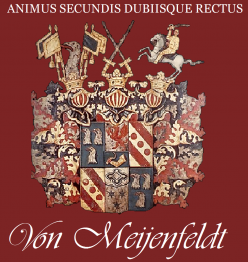Pastor Rolf Kneiβl, glewitz@pek.de, Denkmalpflegerin Beatrix Dräger-Kneiβl, b.draeger-kneissl@lakd-mv.de, Gutsanlagen, Pflasterstraßen, Orgeln, Landesamt für Kultur und Denkmalpflege MV, Domhof 4/5, 19055 Schwerin, Telefon: 0385-58879328
CH-765
Bilthoven, 21 augustus 2022
Lieber Pastor Rolf Kneiβl,
Excuse me for writing in English. You might remember how bad my German writing skills are.
It was a joyful occasion that we met this morning. I visited you in 2003 with my son Lester to study the Kirchbücher of Glewitz. That is quite a long time ago.
After seeing the small nice chapel of Medrow we went to the Hagenow Gutshaus. We needed a second look to find it hidden in the bushes. It might collapse.
In the afternoon we had a delightful meeting with Klaus. His memory is very sharp. I left my e-mail address with him to hand it over to you, in order to send me the article of your wife about the Meijerfeldt family. With this e-mail you have it just in case of any difficulty in reading or spelling.
Klaus hoped that Matthias Posenauer would finish the restauration job of the loge soon. A different story is the Meijerfeldt Gruft. If anything might happen in due course Klaus promised to inform both Henk van Luijk and me.
With warm regards,
Hugo
Bilthoven, 31 augustus 2022
Dear Ms. Beatrix Dräger-Kneiβl,
One and a half week ago I met your husband in Medrow. That was a nice surprise, because we met 19 years earlier when I researched the Birth, Marriage and Burial Registers of Medrow to find more clarity about my ancestors.
Your husband told me you had finished an article about the Meyerfeldt family in Swedish Pomerania. Klaus Bergemann explained to me that you have studied my book in the Dutch language and perhaps my website https://meijenfeldt.nl/.
Of course I am very anxious to read your article. Has it been published already and if yes, could you send me a copy?
Thank you very much in advance,
Hugo von Meijenfeldt
Schwerin, 19 september 2022
Dear Mr. Meijenfeldt,
thanks for your interest in my article to Nehringen. The article has not yet been published. It will be at the end of this year or beginning of 2023. I will send you a copy. In case I will forget it, please send me another email. I’m glad to hear of your interest.
Best greatings,
Beatrix Dräger-Kneißl

Bilthoven, 15 januari 2023
Dear Ms. Beatrix Dräger-Kneiβl,
Best wishes for 2023 to you as well.
Yesterday I received the copy of KulturERBE in Mecklenburg und Vorpommern. Thank you very much for sending it to me. The layout of the magazine is beautiful.
I had a first quick reading of your opening article “Das Gutsdorf Nehringen. Ein bedeutendes schwedisches Erbe in Vorpommern und seine jüngere Geschichte”. The Swedish family von Meyerfeldt plays an import part. I am glad that my book and my website helped you out, also with details about the building history.
I will give the article a closer look and a critical reading, as you invited me to do. Who knows my comments could be used in future articles, e.g. on Glasshüte or shipbuilding.
Best regards,
Hugo G. von Meijenfeldt
Bilthoven, 22 januari 2023
Dear Ms. Beatrix Dräger-Kneiβl,
In my email of 15 January I promised to have a closer look and a critical reading of your article.
I’m very impressed by the content and have read many new facts. It costs me a lot of effort to find a few small additions and corrections:
King Carl XII decided on 23 August 1711 that Johann August von Meyerfeldt d.Ä. would get Lehngut Nehringen from Ridderhielm. I am not a skilled reader of old handwritings, but as far as I can see the defence of Stettin is not mentioned as a reason. On top of that, the defence of Stettin was two years later. The king appointed Meyerfeldt as Öfwercommandant i Stettin on 30 August 1710 (not in 1705). The Russians arrived at the city 24 May 1712, left 25 October because of failing artillery, returned July 1713 with Saxonian and Danish artillery and after two heavy bombardments Meyerfeldt surrendered 21 September 1713. His brave defence is mentioned in the king’s decision of 3 March 1714 to raise Meyerfeldt’s noble title from Baron to Count. In 1713 he became Governor General over Swedish Pomerania Kungligt Råd in the Senate in Stockholm (not Riks Råd or Reichsrat). In the years 1715-1720 Lehngut Nehringen was in the hands of Danish governor general Franz-Joachim von Dewitz.
With regard to the building activities of the Meyerfeldt family members I have details about all premisses but one: the new Gutshaus in Nehringen. You have the same difficulties, I read. Carl Friedrich was the owner until he died, but I cannot find his testament and in his Bouppteckning there is no mentioning of Nehringen. 1791 was an annus horribilis for the Meijerfeldt family. On 13 March Anna Cartharina’s only daughter Brita drowned herself. On 29 March the 70 years old Carl Friedrich d.J. died and that same day Johan August d.J. signed reluctantly the Oath of Loyalty to the King while resigning as Fieldmarshall. On 25 May Johan August III (son of the latter) died of a two years old severe war wound. As a result Johan August d.J. decided to live in Pomerania for the biggest part of the year. His wife countess Lovisa Augusta Sparre was only 46 years old and used to live in grandeur. I am speculating that this was the main reason to have a new Gutshaus built in Nehringen. By the way: around the circle all four buildings are erected in strict square symmetrical distances of 32 meters.
I have a few additions to the activities on Nehringen:
-
- North-east of Medrow count Meyerfeldt d.Ä. established a Glasshütte. It produced glass between 1736 and 1755, the year that Blasius Hagenow became tenant. Glassmaster was Johann Christoff Andersen. There were 46 jobs. In the churhbook 6 burials are mentioned “auf der Glashütte”. There is a ruling from 1763 about ‘rückständige Miethe’ (Inspectoris und Pensionarii Klugen zu Medrow contra den Pastorem Battus zu Glewitz) in which Gräfin von Meyerfeldt and Glaβmeister Andersen are mentioned.
- De stud farm of Nehringen became famous for its magnificent stallions.
- Enormous oak and pine trees were used to build 17 ships in Bassendorf (on the Lehngut) that had been ordered by the harbourmasters Stralsund and Barth. The Trebel was made navigable to sail these ships south-east through the Peene towards the Baltic Sea under Greifswald (paper clippings of Klaus Bergemann).
- I am not sure if this is part of Kulturerbe, but your husband must know of the scandal pastor Christoph Heinrich Fischer created. He came from Alsleben in Saxony and was appointed in Nehringen during the Danish rule. He kept quiet in the first years after the return of Meyerfeldt, but used indecent and offensive terms in a sermon in 1729. Fischer was immediately suspended and charged, but not dismissed because he swore he did not intend to refer to the governor general. Nevertheless the Danish king appointed him shortly after in Holstein.
Of course you will not rewrite your article and most of my information is not too relevant, but I have learned that you never know what purpose it might serve.
With best regards,
Hugo
3 februari 2023
Lieber Herr von Meijenfeldt,
haben Sie ganz herzlichen Dank für Ihr intensives kritisches Lesen meines Artikels! Sie sind wahrscheinlich der Einzige, der den Artikel dermaßen kenntnisreich und genau durchstudiert!!! Für Ihre Anmerkungen hinsichtlich des Testamentes und der bisher nicht zu klärenden Erbsituation zwischen den beiden Brüdern danke ich Ihnen. Ihre dankenswerterweise eingescannten Schriften kann ich leider auch nicht sicher und souverän lesen. Da müsste man einen Historiker bemühen.
Den Plan mit der Darstellung der Gutsanlage und dem Abstand von 32 m zwischen den Gebäuden kenne ich. Ich wollte ihn erst publizieren, aber Herr von Pachelbel erzählte mir, dass er den Plan etwas geschönt hat, was die Maße betrifft. Da habe ich dann lieber darauf verzichtet, auch wenn es weiterhin spannend ist.
Entschuldigen Sie meine späte Antwort. Ich wollte Ihnen erst auf englisch schreiben, aber das hätte doch zu viel Mühe und Zeit gekostet und ich habe gehört, dass Sie sehr gut deutsch verstehen.
Haben Sie nochmals ganz herzlichen Dank für die Würdigung meines Artikels!
Freundliche Grüße,
Beatrix Dräger-Kneißl
